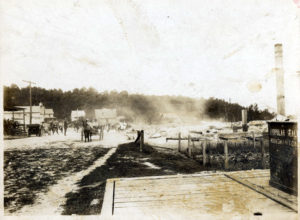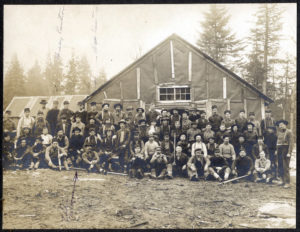How Sister Bay Got Its Name
- Share
- Tweet
- Pin
- Share

There is a little feature you see on a satellite map of the waters just off Sister Bay that looks like a pair of lonely eyebrows. Those are the Sister Islands, a generous name for a pair of rock outcroppings that are recognized by the Wisconsin Department of Natural Resources as an important gull and tern nesting site. The DNR owns the islands and they were designated a State Natural Area in 1966.
The name “Sister” came to represent the bay in which the “islands” were situated, as well as the community that eventually sprang up on its shores. Although in the beginning the settlement was known as Big Sister Bay, “Big” was dropped, possibly when founders realized the shortened version would be BS Bay.

Sister Bay after the fire of 1912, looking west, the remains of the hotel in the foreground. Photo courtesy of the Sister Bay Historical Society.
But what if the fellow who named Sister Islands had not thought of them as sisters, but instead saw them as eyebrows or mustachios (yes, he might have needed satellite vision to perceive them that way, but…), would the vibrant village we know today be the village of Eyebrows Bay or Mustache Bay instead of Sister Bay?
And why sisters? Why not brothers, cousins or fraternal twins? Fraternal Twins Bay certainly has a mysterious ring to it.
Swedish woodchoppers were the first folks to settle in the area we know today as Sister Bay, or, at least, that is the history passed down to us from Hjalmar Holand in his History of Door County.
“They were big, strapping fellows, chopping wood from fall to fall, often making four cords a day, drinking, fighting and eating what they liked,” Holand wrote.
Since land was cheap, many of the woodchoppers stayed and became farmers. Holand claims the rough and ready days of the settlement ended in 1877 when a group of Swedish families organized a Baptist church. “Largely through its influence saloons have been banished from Liberty Grove and Sister Bay.”

Loggers at a logging camp with three men identified: Eddie Nelson, Henry Knutson, William Knutson. Circa 1910. Photo courtesy of the Sister Bay Historical Society.
But it was apparently a combination of saloons and roads that inspired the residents of Sister Bay to break off from the township of Liberty Grove and petition to become a village in 1912. The temperance movement was raging in the country and in Door County in 1912. Liberty Grove was talking about going dry and Sister Bay residents didn’t agree.
The other factor was that when it came to road maintenance, Sister Bay felt it was getting the short end of the stick from the town. Village residents felt they could do a better job of maintaining their roads themselves.
That pioneer independence seems to thrive to this day in the vibrant village of Sister Bay, but think of all the fun the village could have if the guy who named the islands wasn’t hung up on his sisters.


